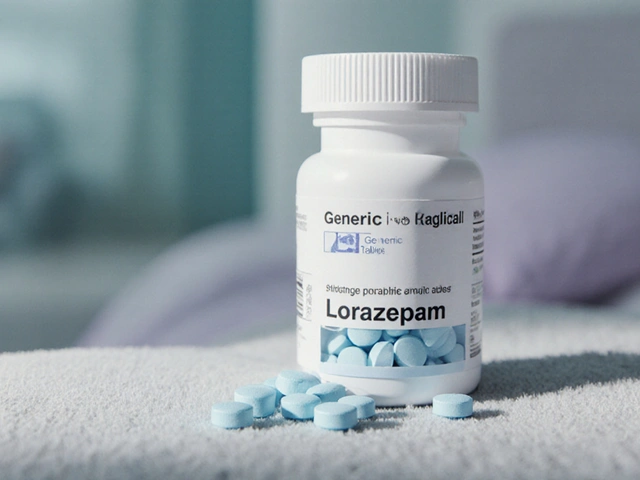When your doctor prescribes an antibiotic for a stubborn infection, you might not think twice about the name-until you start comparing clarithromycin and azithromycin. Both are macrolide antibiotics, both are used for respiratory and skin infections, and both come in pill form. But they’re not the same. One might clear your sinus infection faster. The other might cause less stomach upset. Choosing between them isn’t about which is "better" overall-it’s about which fits your body, your infection, and your lifestyle.
How Clarithromycin and Azithromycin Work
Both clarithromycin and azithromycin belong to the macrolide class of antibiotics. They stop bacteria from making proteins they need to survive and multiply. Think of it like cutting off the factory lines that produce weapons for an invading army. Without those proteins, the bacteria can’t spread, and your immune system can clean up the rest.
Clarithromycin, sold under brand names like Biaxin, was approved in the U.S. in 1991. It’s a slightly modified version of erythromycin, designed to be more stable in the stomach and more effective against certain bacteria. Azithromycin, sold as Zithromax or Z-Pak, came out in 1992 and was engineered to last longer in the body. That’s why you often take azithromycin for just five days-or even just one big dose-while clarithromycin usually requires twice-daily pills for 7 to 14 days.
What Each Antibiotic Treats
There’s overlap in what they treat, but the differences matter.
- Clarithromycin is often used for sinus infections, bronchitis, pneumonia, and skin infections. It’s also a key part of the triple therapy used to kill H. pylori, the bacteria that cause stomach ulcers. In fact, the CDC recommends clarithromycin as a first-line option for this specific use.
- Azithromycin is the go-to for chlamydia, gonorrhea (when combined with ceftriaxone), and some ear infections in kids. It’s also preferred for walking pneumonia caused by Mycoplasma pneumoniae. Because of its long half-life, it’s often used in single-dose regimens for sexually transmitted infections, making it easier for patients to complete treatment.
For strep throat, both work-but azithromycin is sometimes chosen for people who can’t take penicillin and need a shorter course. For chronic bronchitis flare-ups, clarithromycin has shown better results in some studies because it stays active in lung tissue longer.
Dosing: Convenience vs. Consistency
One of the biggest practical differences is how you take them.
Azithromycin’s magic trick is its long half-life-68 hours. That means after you take a dose, it keeps working in your body for days. A typical Z-Pak is: one 500 mg pill on day one, then 250 mg daily for four more days. Some doctors even prescribe a single 1-gram dose for chlamydia.
Clarithromycin? You take 250 to 500 mg twice a day, every 12 hours, for 7 to 14 days. Missing a dose can drop your blood levels too low, letting bacteria bounce back. If you’re the type who forgets to take pills, azithromycin’s simpler schedule might be the better fit.
But here’s the catch: azithromycin’s long stay in your system means it can interact with more drugs over a longer window. Clarithromycin, while requiring more pills, clears out faster and has fewer lingering interactions.
Side Effects: Stomach Trouble and More
Both can cause nausea, diarrhea, and stomach cramps. But studies show azithromycin causes less gastrointestinal upset overall. One 2020 meta-analysis in the Journal of Antimicrobial Chemotherapy found that 18% of people on clarithromycin reported moderate to severe stomach issues, compared to 11% on azithromycin.
Clarithromycin has a higher risk of interacting with other medications. It blocks an enzyme in your liver called CYP3A4, which breaks down many common drugs. That means if you’re on statins like simvastatin, blood thinners like warfarin, or certain heart rhythm meds, clarithromycin can cause dangerous buildup. Azithromycin doesn’t do this as strongly-making it safer for people on multiple prescriptions.
Both can rarely cause heart rhythm problems, especially in older adults or those with existing heart conditions. The FDA issued a warning in 2013 about azithromycin and QT prolongation, but the actual risk is low for healthy people. Clarithromycin carries a similar warning, but it’s more likely to cause liver enzyme spikes.

Cost and Accessibility
Generic versions of both are widely available and cheap. In the U.S., a 5-day course of azithromycin can cost as little as $10 at Walmart or CVS with a GoodRx coupon. Clarithromycin isn’t much more-usually $15 to $25 for a 10-day course.
Insurance plans often favor azithromycin because of its shorter course and lower risk of drug interactions. Some formularies list it as preferred for community-acquired pneumonia. Clarithromycin might require prior authorization if you’re on other meds.
When One Wins Over the Other
There’s no universal winner. It depends on your situation.
Choose azithromycin if:
- You have chlamydia or gonorrhea
- You need a simple, short course (like a Z-Pak for bronchitis)
- You’re on other medications that interact with clarithromycin
- You have trouble remembering to take pills twice a day
Choose clarithromycin if:
- You have a stomach ulcer caused by H. pylori
- You have a stubborn sinus infection that didn’t respond to other antibiotics
- Your doctor suspects a more resistant strain of bacteria
- You’re not taking other drugs that could interact dangerously
For pneumonia, some guidelines now prefer azithromycin because it covers atypical bacteria like Mycoplasma and Chlamydophila. But for severe pneumonia in older adults, clarithromycin might be preferred because it penetrates lung tissue more deeply.
What Patients Say
Real-world feedback backs up the data. On patient review sites, azithromycin gets higher ratings for ease of use. One 62-year-old woman wrote: "I took Z-Pak for my cough. One pill a day for five days. I didn’t miss a single one. Clarithromycin? I’d forget the afternoon dose every time. And my stomach hated it."
But another patient with a recurring sinus infection said: "I took azithromycin twice. It didn’t touch my infection. My doctor switched me to clarithromycin-and within three days, I could breathe again. It worked where the other didn’t."
That’s the point: bacteria adapt. Your body reacts differently. What worked for your neighbor might not work for you.

Resistance and Long-Term Use
Overuse of any antibiotic leads to resistance. Macrolides aren’t immune. In fact, resistance to azithromycin is rising faster in some regions, especially for strep throat and gonorrhea. The CDC reports that over 20% of gonorrhea strains in the U.S. are now resistant to azithromycin, which is why it’s now always given with another antibiotic.
Clarithromycin resistance is also growing, especially in H. pylori. That’s why triple therapy now often includes a proton pump inhibitor and another antibiotic like metronidazole. If clarithromycin fails, your doctor won’t try it again.
The bottom line: neither drug is a magic bullet. They’re tools. And like any tool, their effectiveness depends on how-and when-you use them.
What to Ask Your Doctor
Before you take either, ask:
- What infection am I treating, and which bacteria is most likely causing it?
- Do I have any other health conditions or medications that could interact with this drug?
- Is there a reason you’re choosing this one over the other?
- What should I do if I don’t feel better in 3 to 4 days?
Don’t assume one is "stronger" or "better." The best antibiotic is the one that matches your infection, your body, and your life.
Can I switch from clarithromycin to azithromycin if I have side effects?
Don’t switch antibiotics on your own. If you’re having side effects, contact your doctor. They might adjust the dose, prescribe an anti-nausea med, or switch you to azithromycin if it’s safe and appropriate. Stopping or switching mid-course can lead to treatment failure or antibiotic resistance.
Is one better for children?
Azithromycin is more commonly prescribed for kids because it comes in liquid form and has a simpler dosing schedule. It’s often used for ear infections and pneumonia in children. Clarithromycin is also approved for kids, but it’s usually reserved for specific cases like H. pylori or stubborn sinus infections because of its twice-daily dosing and higher risk of stomach upset.
Can I drink alcohol with either antibiotic?
Alcohol doesn’t directly interact with clarithromycin or azithromycin like it does with metronidazole. But both can cause stomach upset, and alcohol can make that worse. It’s best to avoid alcohol while taking either antibiotic to let your body focus on healing.
Do I need a prescription for either?
Yes. Both clarithromycin and azithromycin are prescription-only antibiotics in the U.S. and most other countries. Buying them online without a prescription is illegal and risky-you could get counterfeit pills, wrong dosages, or expired medication.
How long does it take to feel better?
Most people start feeling better within 2 to 3 days of starting either antibiotic. But you must finish the full course-even if you feel fine. Stopping early can leave behind the toughest bacteria, which then multiply and become resistant. If you don’t feel better after 4 days, call your doctor. You might have a virus, a different infection, or a resistant strain.
Next Steps
If your doctor prescribes clarithromycin or azithromycin, take it exactly as directed. Keep a list of all your other medications and supplements to avoid dangerous interactions. If you’ve had side effects from antibiotics before, tell your doctor. They can choose one that’s less likely to cause problems.
Antibiotics aren’t interchangeable. They’re targeted weapons. The right one, at the right time, makes all the difference. Don’t guess. Ask questions. And trust your doctor’s choice-not the internet.










Azithromycin worked for my sinus infection. Clarithromycin made me puke. Simple.
Man, I took Z-Pak once and felt like a superhero-just one pill a day and my cough vanished. Clarithromycin? Nah, that stuff feels like a full-time job. I forget the second dose and then my gut throws a tantrum. 🤮
It's fascinating how the pharmacokinetics of these two drugs reflect entirely different clinical philosophies. Azithromycin’s prolonged tissue half-life suggests a strategy of sustained, low-level suppression-ideal for outpatient compliance and STIs. Clarithromycin, with its shorter half-life and higher CYP3A4 inhibition, demands more precision but offers deeper tissue penetration, especially in lung parenchyma. This isn’t about superiority; it’s about matching drug behavior to infection location and patient behavior. The fact that H. pylori eradication requires clarithromycin in triple therapy underscores its unique bioavailability in gastric mucosa. We’re not choosing between two antibiotics-we’re choosing between two physiological strategies.
I’ve been on both. Azithromycin felt like a magic bullet-until it didn’t. My recurrent sinus infection laughed at it. Clarithromycin? Took three days, but my sinuses finally stopped feeling like a swamp. I get why people prefer the Z-Pak. But if your infection’s stubborn, don’t be fooled by convenience. Sometimes the harder path works better.
!!!THEY’RE BOTH CONTROLLED BY BIG PHARMA TO KEEP YOU DEPENDENT!!! CLARITHROMYCIN IS DESIGNED TO MAKE YOU NEED MORE DOSES BECAUSE THEY OWN THE PATENTS ON THE TWICE-DAILY FORMULA!!! AZITHROMYCIN? IT’S A TRAP TO MAKE YOU THINK YOU’RE SAFE-BUT IT’S JUST A SLOW-POISONING STRATEGY TO INCREASE LIVER DAMAGE STATS!!! THE FDA IS IN ON IT!!!
I read somewhere that azithromycin is used in mass distribution programs in poor countries because it’s cheap and easy… but what if they’re just testing antibiotic resistance on us? I mean, why would they give it to millions if it wasn’t part of some global experiment? 🤔
In India, we are told azithromycin is the "miracle pill"-but I have seen too many patients with resistant infections after repeated use. The pharmaceutical companies market it as a cure-all, yet the WHO has warned of rising macrolide resistance since 2018. Are we being sacrificed for profit? The silence from our medical institutions is deafening.
Okay but like… have you ever actually read the side effect list for clarithromycin? It’s basically a horror show. I was on it for a sinus infection and ended up in the ER because my liver enzymes were through the roof. My doctor just shrugged and said, "Oh, that’s common." Common?! That’s not common, that’s a red flag they ignore because azithromycin is cheaper for insurance. I’m not mad, I’m just disappointed.
Take what your doctor prescribes. Don’t switch. Don’t google. Finish the course. Antibiotic resistance isn’t a theory-it’s happening right now in your community.
USA got the best meds. Azithromycin? Made here. Clarithromycin? Mostly imported. If you’re in the US, trust the American-made one. We don’t need foreign pharmaceuticals messing with our health. 🇺🇸💪
i took azithromycin and my stomach was like a war zone but at least i only had to remember one pill a day. clarithromycin? i kept forgetting the 2nd one and then i felt worse. my doc was like "just take it" but like… i’m not a robot. also i think the zpak is just a marketing trick to make people feel better about taking antibiotics. why do we even need pills for this? 🤷♀️
It is imperative to underscore that the proliferation of macrolide antibiotics in primary care settings, without adequate microbiological diagnostics, constitutes a profound public health failure. The assumption that clinical presentation alone justifies empirical prescribing is not merely outdated-it is dangerously negligent. Resistance profiles vary regionally, yet prescriptions are issued as if microbial ecology is monolithic. The FDA warnings regarding QT prolongation, while statistically low in incidence, remain non-trivial in populations with comorbid cardiac conditions. To prescribe without evaluating concomitant medications, renal function, and prior exposure history is not medical practice-it is negligence cloaked in convenience. The patient who reports "it worked for my neighbor" is not contributing to evidence-based medicine; they are perpetuating a dangerous myth. The correct antibiotic is not determined by anecdote, but by susceptibility testing, pharmacokinetic alignment, and individual risk stratification. Anything less is not treatment-it is gambling with public health.